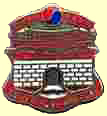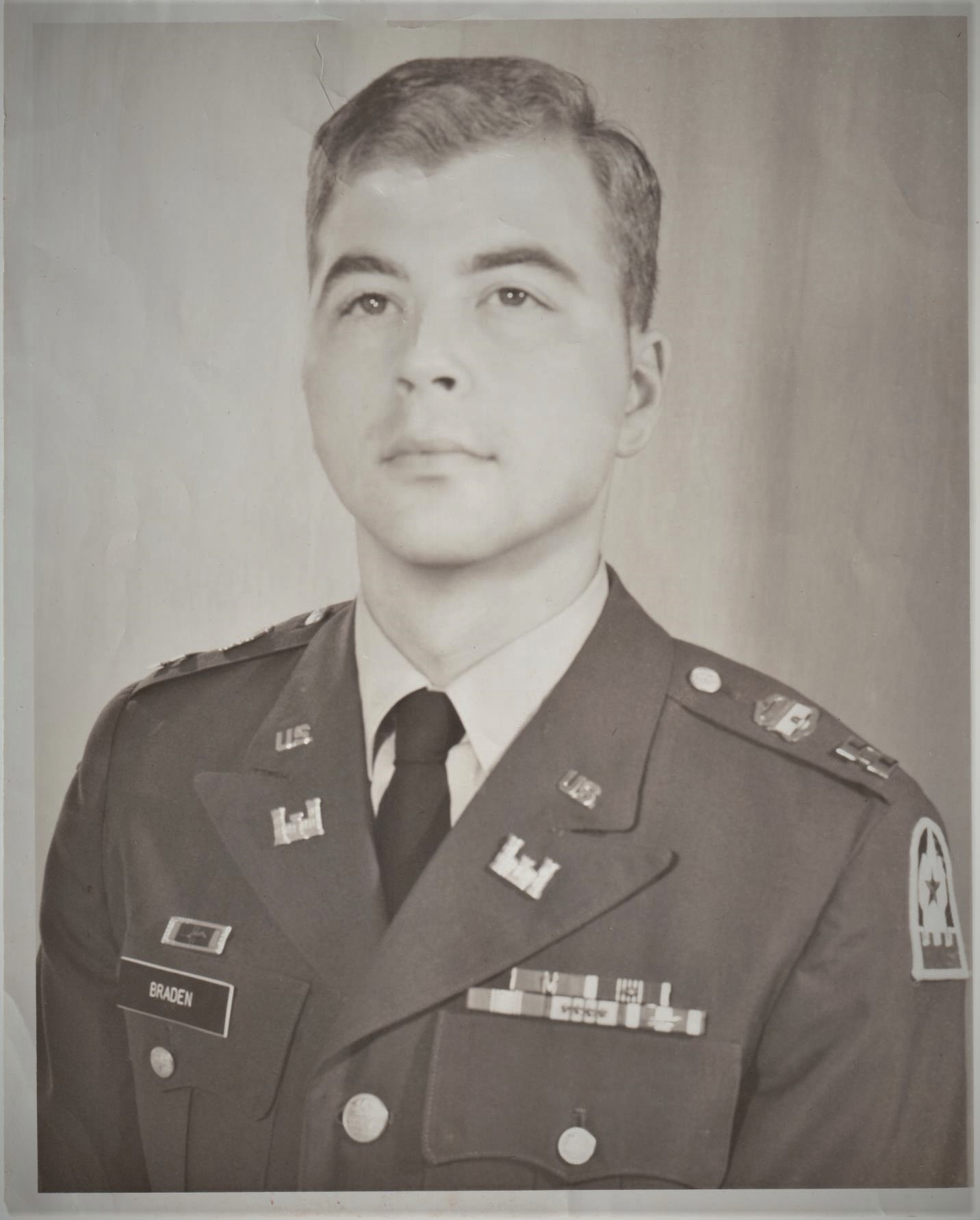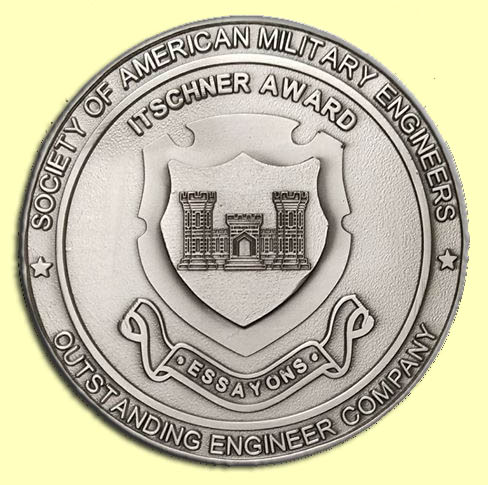
| These are some personal notes that describe some of my memories and opinions of the organizations that I served with in an Army career that spanned nearly 30 years. If you find this site by accident through a search engine you are welcome to contact me and share your thoughts. Thanks. My e-mail address is BradenClan@ gmail.com. |
370th Engineer Company (Construction Support)Kaiserslautern, Germany 1973-1975
I was assigned to the 370th following my instructor duties with the Engineer School. I left for Germany on my own as Bonnie had just given birth to Sandra, and needed some time
The 370th Engineer Company (Construction Support) was part of the 24th Engineer Group (Construction). It was located, along with the Group Headquarters, at Kleber Kaserne. By
Shortly after I arrived and before Bonnie and the two (at that time) girls arrived, I went for a week to Company Commander School at Oberammergau. We had a conscript Army at the time. Fellow officers at the school were saying things like, “The only way I’d walk through my company area at night is with a .45 on my hip.” Wow, welcome to Germany. For the record: I never felt like I needed to be armed in my own company for any part of the next two years.
The motto of the 370th was "One of a Kind in Europe." True. The 370th was the only construction support company in Germany. It was also an ALO 3 unit and its equipment had mostly exceeded its projected lifespan. The Authorized Level of Organization of 3 meant that personnel staffing was low and that its priority for repair parts was equally low, as most USAREUR units were ALO 2. Considering the low density of equipment and its age, we were always looking for the repair parts to keep the aged equipment running. We frequently visited Property Disposal yards to rumage through junk equipment to find the repair parts to keep what we had going. Our operators and mechanics were continually challenged in this regard.
The First Sergeant of the 370th for most of my time there was Al Williams. He and I exchanged Christmas cards until he died on Easter Sunday in 2011. 1SG Williams was a great soldier, and ran the company well. His wife Ruth was German, and he had spent a number of years in Germany. He spoke the language and knew the many ways to get things done. He spent a lot of time with his NCOs to ensure they knew his expectations and that the events of each day would be accomplished in a professional manner. He also spent a lot of time with 24th Group Command Sergeant Major Butler, another great NCO. Since the company was right under the nose of the group headquarters, it didn't hurt to someone on the inside as a friend. We had some great NCOs in the company: Larsen, Leahy, Romero, Norton. This was Cold War time, and I have no doubt that if the Russian generals saw the professionalism and skills of these men they would have caved in much earlier. Art Larsen went on the make Command Sergeant Major and is the author of The CSM Creed. We also had some excellent lieutenants: Duke, Grayson, Golden. David Duke left the Army shortly after being reassigned from the 370th and went on to be rich and famous - a true loss to the military.
The company had just moved into renovated barracks, a true blessing. Many of the barracks for USAREUR soldiers were in terrible shape, and this really affected morale. I had a privilege that most commanders would envy. New barracks were nice, but 1SG Williams and his NCOs had bigger plans. On the outside they installed pipe around the parking area to define that space, and on the inside they took sledgehammers to the walls of the first floor corridor and created indented, glass-door trophy cases. The Supply Sergeant, SSG Boucher, also came up with paneling, and that was also installed in many of the common areas. The finished effect was great. Then the First Sergeant and I had a discussion about what to put out front to really define the company. I had seen armor units with an old tank sitting out front of their unit, on the ground on a concrete slab. We needed something like that. The suggestion was that our symbol would be a large bullldozer. and instead of having it sit on the ground, it would rest on top of a pedestal. The pedestal would look like a T with the neck of it coming out of the ground with a column just 18" across. 1SG Williams was skeptical about a bulldozer on a platform with such a small base. I told him. "You get the bulldozer and I'll design the platform. We had a deal. Only he had the dozer with three days - he signed for a junk HD-16 from the PDO yard and had it down in the motor pool for painting and other outside refurbishments. It took me a bit to design the platform (shear was the major issue) but I did it. The platform was built, the dozer mounted on top using one of our 40 ton cranes, and we had a most inspiring entrance to our company.
Another blessing for the company was that it had a company lounge operating in the basement of the building as part of its unit fund. At one point USAREUR had tried to do something for isolated units that were distant from PX facilities, so the command authorized units to run their own little PX operation to serve themselves. Kleber Kaserne in Kaiserslautern was not isolated, but the regulation had evidently not defined what isolated meant, so the company had its lounge. Then USAREUR found that company lounges tended to be mismanaged, and it was in the process of closing down every one found to be outside the regulatory guidance. But a lounge was a GREAT idea. Your soldiers would spend their money to add to your unit fund. Your soldiers could have a few beers and walk upstairs to their quarters and not have to drive to get home. And if your soldiers got a bit rowdy, the situation could be resolved by unit NCOs and the matter handled in-house rather than being handled by the military police. MPs meant going to the station to pick up soldiers involved in misconduct and answering the blotter report that would soon come down through channels, which meant through the 24th Group in my case. So the good news was that we had a unit lounge, but the bad news was that it was grossly mismanaged and would never survive a command inspection. I spent a lot of time and effort getting it straight, and we squeezed by that first inspection. We kept it running right thereafter, with numerous benefits. The fact was that we had more unit fund money than we could spend. We had jerseys for all the unit sports and there were times when we would put cases of beer in the hall and tell soldiers to help themselves (after duty hours).
The company had an asphalt paving project in Pirmasens, Germany, about 30 minutes south of my quarters in Volgelweh Housing. For something like 48 straight days we paved, taking advantage of good weather. Each morning I got up, dressed, and drove to Pirmasens to be there as the plant was fired up. I stayed there until around 6 p.m. when the plant was shut down, and then drove north to Kaiserslautern and across town to Kleber Kaserne where I did other company business, to include oversight of my other platoons. Keeping that plant running was a Herculean task, and our company warrant officer, WO1 Richard Hunley, was amazing in his efforts. Bonnie and I still maintain regular contact with Rich and Ginger Hunley. Richard recently retired as a successful building contractor in the Clarksville, Tennessee area. He nows flys his four-seater plane and relaxes in a wonderful house that he built.
The company also received its first woman soldier, as the post-Vietnam army opened the doors to more females. PFC Karen Longstreth had MOS 62M, Forklift Operator. We wondered how to accommodate her into an all-male barracks. We also wondered how she would "fit" in the equipment platoon as a heavy machine operator. The suggestion was made that she should be assigned to work in the orderly room, assuming she could type, but I said no. She enlisted to be a forklift operator and that's what she would be. Besides, she would be under the watchful eyes of SSG Romero, the fine Platoon Sergeant of the Equipment Platoon, so she would be in good hands. Longstreth - as I understand - did get some hazing due to being a female (She recalls a time when her platoon mates put her in the Crane Basket and hoisted her a great distance above the ground), but we just didn't tolerate that type behavior and soon she was just another soldier in the company . . . well, almost. She did have her own private outhouse for bivouacs that was painted camouflage on the outside and pink on the inside. (Karen went on to stay in the Army Reserves, retiring as a Master Sergeant. She then went on to ultimately be a contract specialist, GS-12, with FEMA, retiring in June 2011.)
The company Dining Facility actually served six other company-sized units on the kaserne. I learned a lot about dining facility operations and as a battalion and brigade commander I tried to pass that knowledge on to my company commanders.
I'm not exactly sure how this came about - I think it was through one of the Department of the Army civilians at Pirmasens who had French contacts - but the 370th travelled to Bitche, France, just south of Pirmasens, on two or three occasions to visit the Maginot Line. The French Army maintained the fortress at Bitche, which was closed to the public. We got our own private tours, and they were fantastic. We saw the infrastructure as in the railroad line within the tunnels to carry munitions, the sleeping areas, the kitchen facilities, the chemical defense filters for the air, the hospital, and the billet areas. We saw the pop-up turrets with their rotating guns. Magnificent does not quite describe the experience. As a side note, we also gave our French hosts a present, normally some bottles of Jack Daniels that were much appreciated. We also presented them with a company certificate. I had forgotten the the company lineage had gone back to WWI and that we had the WWI campaigns in France highlighted on the certificate. The French picked up on this right away, and I suspect this made us even more welcome.
The 370th won the Itschner Award as the Best Engineer Company in the US Army. Kudos to everyone who helped assemble our nomination book, but especially to First Lieutenant Bryan Golden who was tremendously talented as a writer. You can do great things,
The company was unique in the very close relationships we have among our officers and NCOs. We had a sense of camaraderie that was evident to other organizations. Some of our unit parties were just great and 1SG Williams always managed to get us a bus to take the Bad Durkheim wine fest. (Thank heaven for the designated driver.) I still have contact with a few NCOs from the unit.
The company was inactivated as part of restructuring forces in Europe; I was its last commander. When we went to turn in a lot of our equipment, the maintenance inspectors classified it as having no further useful life and it ended up in the PDO (Property Disposal) yard, where we always suspected it should have been in the first place. As part of the inactivation, we took the HD-16 off the pedestal and returned it also to the PDO yard. I visited Kleber Kaserne a number of years later. A different company was in the building, but the pedestal was still there.
As to the company; well, it essentially went away. That's kind of hard on me, though it's now nice to know that the unit has been reactivated. Yes, I would have all wanted to company to live on so I could go back to K-Town every now and then for a reunion and swaps stories and lies. But the fact is that most of the soldiers and officers were not career military and went on to other things. I do think they all benefitted from serving with the 370th, and – though – we’ll never know, I’ll bet that replica Itschner Award sits on many a wall through the U.S. As to the NCOs, we know that most went on to greater things, so that's a tribute to the leadership of 1SG Williams. All in all, I'd say that this assignment resulted in a lot of fond memories and a sense of pride in the unit's accomplishments.
My time with the 370th also generated some good stories, and they can be found here.
p.s. As I said above, the 370th has been reactivated. It is a sapper engineer company under the 54th Engineer Battalion in Bamberg, Germany. In June of 2009 it returned from a successful 15-month tour of sweeping for IEDs in Iraq. |



 before she could travel with the baby. We were assigned quarters in Vogelweh Housing, in Kaiserslautern, on the third floor of a stairwell apartment. This was the first but not the last of third floor stairwells that would characterize our housing in Germany.
before she could travel with the baby. We were assigned quarters in Vogelweh Housing, in Kaiserslautern, on the third floor of a stairwell apartment. This was the first but not the last of third floor stairwells that would characterize our housing in Germany.

 but it takes a great writer to document them. Bonnie and I were flown back to Fort Belvoir for the Annual Engineer Dinner where I accepted the award officially on behalf of the company. Back in Kaiserslautern we had a replica of the award made locally for $10 and many soldiers bought one. I still have mine. Though I accepted the award, it really went to the NCOs of the company who collectively earned it. We did that the first year I was there, and we were actually a better company the second year.
but it takes a great writer to document them. Bonnie and I were flown back to Fort Belvoir for the Annual Engineer Dinner where I accepted the award officially on behalf of the company. Back in Kaiserslautern we had a replica of the award made locally for $10 and many soldiers bought one. I still have mine. Though I accepted the award, it really went to the NCOs of the company who collectively earned it. We did that the first year I was there, and we were actually a better company the second year.